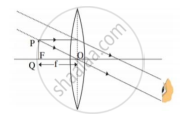Advertisements
Advertisements
प्रश्न
An object is placed 20 cm from (a) a converging lens, and (b) a diverging lens, of focal length 15 cm. Calculate the image position and magnification in each case.
उत्तर
) Focal length of the converging lens, i.e., convex lens f = + 15 cm
Object distance u = - 20 cm
Using the lens formula:
`1/f=1/v-1/u`
⇒`1/15=1/v-1/-20`
⇒`1/15=1/v+1/20`
⇒`1/v=1/15-1/20`
⇒`1/v=(4-3)/60=1/60`
∴ v = +60 cm.
Therefore, the image formed is real. It is at a distance of 60 cm from the lens and to its right.
`"Magnification" ="image distance"/ "object distance"`
∴ `m=v/u=60/-20=-3`
The magnification is greater than 1. Therefore, the image is magnified.
The negative sign shows that the image is inverted.
(b) Focal length of the diverging lens, i.e., concave lens f = - 15 cm
Object distance u = - 20 cm
Using the lens formula:
`1/f=1/v-1/u`
⇒`1/-15=1/v-1/-20`
⇒`1/v=1/-15-1/20`
⇒`1/v=(-4-3)/60=-7/60`
∴ v = - 8.57 cm.
Therefore, the image formed is virtual. It is at a distance of 8.57 cm from the lens and to its left.
`"Magnification"="image distance"/"object distance"`
∴ `m=v/u=(-8.57)/-20=+0.42`
The magnification is less than 1. Therefore, the image is diminished. The positive sign indicates that the image is erect.
APPEARS IN
संबंधित प्रश्न
An object is placed at a distance of 15 cm from a convex lens of focal length 20 cm. List four characteristics (nature, position, etc.) of the image formed by the lens.
Draw a labelled ray diagram to show how a ray of light is refracted when it passes:
from an optically denser medium into air.
A convex lens of focal length 15 cm produces a magnification of +4. The object is placed:
(a) at a distance of 15 cm
(b) between 15 cm and 30 cm
(c) at less than 15 cm
(d) beyond 30 cm
Draw a diagram to represent the second focus of a convex lens.
Analyse the following observation table showing variation of image-distance (v) with object-distance (u) in case of a convex lens and answer the questions that follow without doing any calculations:
| S. No. | Object-Distance u (cm) |
Image-Distance v (cm) |
| 1 | –60 | +12 |
| 2 | –30 | +15 |
| 3 | –20 | +20 |
| 4 | –15 | +30 |
| 5 | –12 | +60 |
| 6 | –9 | +90 |
(a) What is the focal length of the convex lens? State reason for your answer.
(b) For what object-distance (u) is the corresponding image-distance (v) not correct? How did you arrive at this conclusion?
(c) Choose an appropriate scale to draw a ray diagram for the observation at S. No. 4 and find the approximate value of magnification.

i. Which type of microscope has the arrangement of lenses shown in the adjoining figure?
ii. Label the figure correctly.
iii. Write the working of this microscope.
iv. Where does this microscope used?
v. Suggest a way to increase the efficiency of this microscope.
A lens always forms an image between the object and the lens.
A lens always forms an image between the object and the lens.
State the nature and position of the object on the principal axis to obtain a real image of the same size
 : Object near the lens : : ______ :
: Object near the lens : : ______ : 
 |
 |
The above images are that of a specialized slide projector. Slides are small transparencies mounted in sturdy frames ideally suited to magnification and projection since they have a very high resolution and a high image quality. There is a tray where the slides are to be put into a particular orientation so that the viewers can see the enlarged erect images of the transparent slides. This means that the slides will have to be inserted upside down in the projector tray.
To show her students the images of insects that she investigated in the lab, Mrs. Iyer brought a slide projector. Her slide projector produced 500 times enlarged and inverted image of a slide on a screen 10 m away.
a. Based on the text and data given in the above paragraph, what kind of lens must the slide projector have?
b. If v is the symbol used for image distance and u for object distance then with one reason state what will be the sign for `"𝑣"/"𝑢"` in the given case?
c. A slide projector has a convex lens with a focal length of 20 cm. The slide is placed upside down 21 cm from the lens. How far away should the screen be placed from the slide projector’s lens so that the slide is in focus?
OR
c. When a slide is placed 15 cm behind the lens in the projector, an image is formed 3 m in front of the lens. If the focal length of the lens is 14 cm, draw a ray diagram to show image formation. (not to scale)
